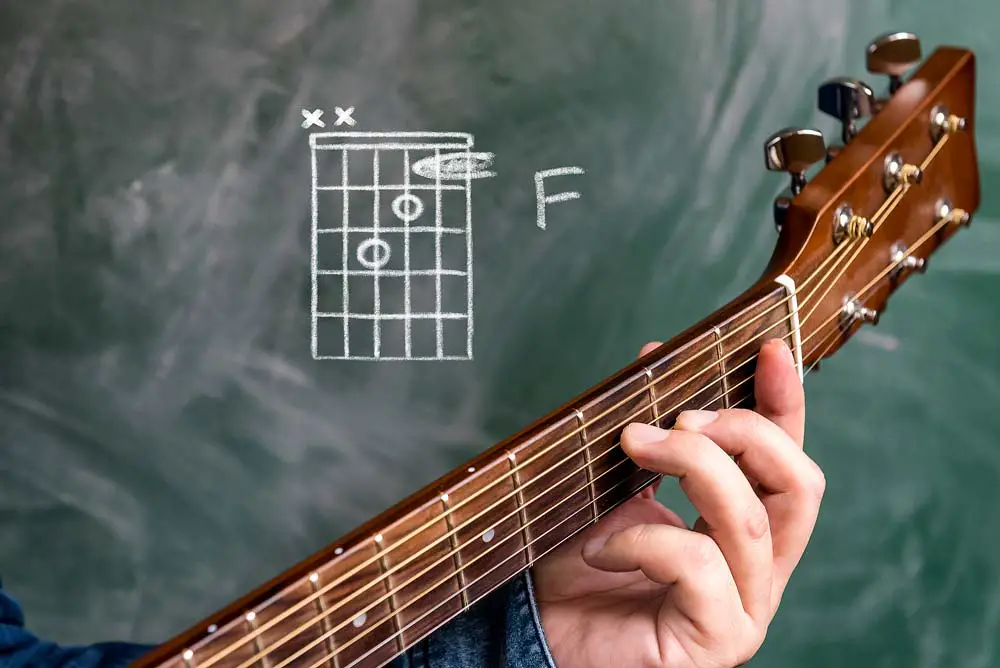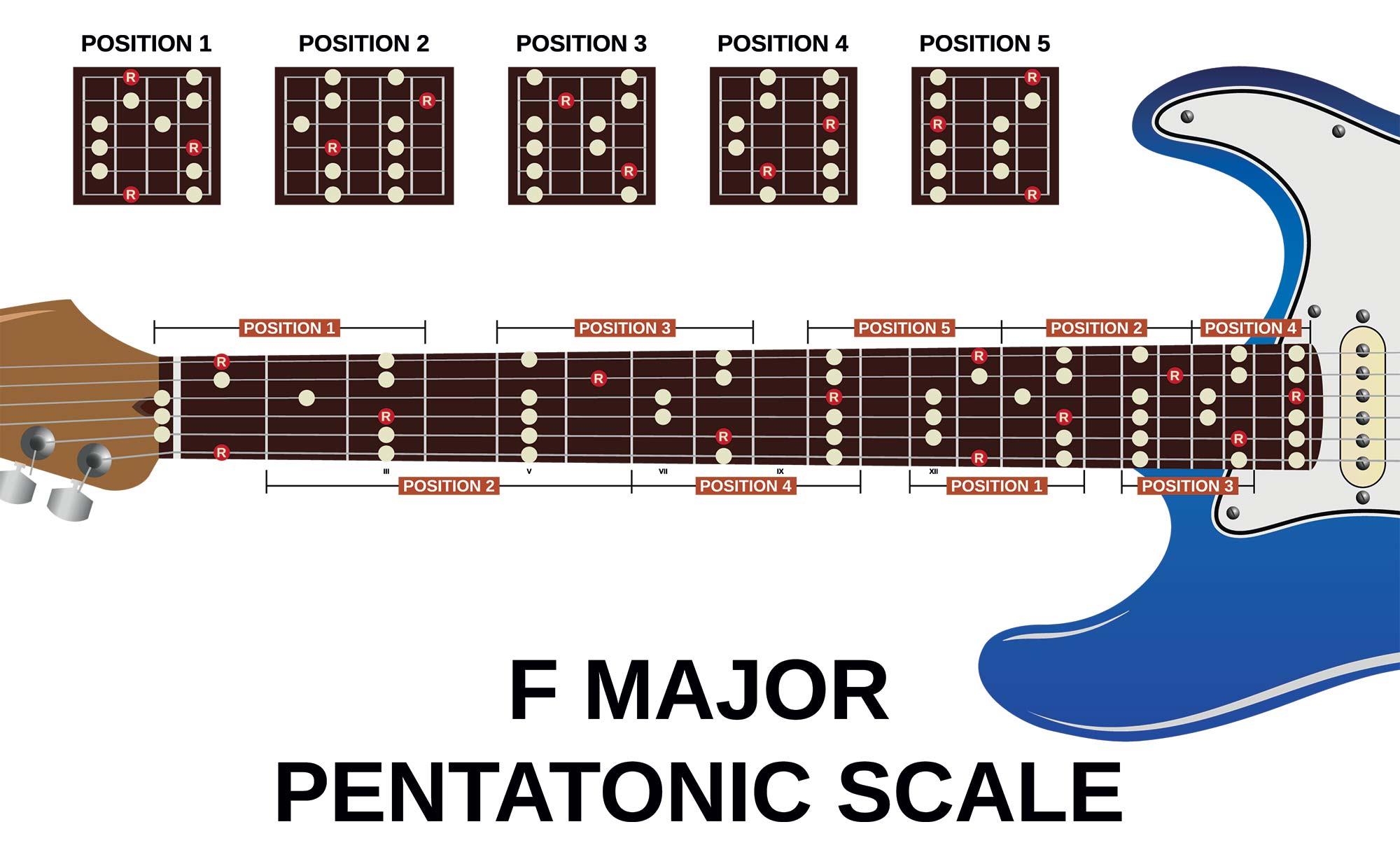The F major guitar chord, hated by beginners but beloved by established players. If you’ve ever tried to learn the F guitar chord then you know exactly what I’m talking about when I mention the word; frustrating! But, what makes the F chord so painstakingly difficult at the beginning largely boils down to misinformation.
By misinformation, I mean that most beginners try to start learning the F major barre chord and not the simplified variations that provide a much easier solution (to begin with!).
In today’s article, we’re going to be looking at a variety of F guitar chord shapes and take you on a musical journey from beginner to advanced. Be sure to check out our previous “how to play” chord article, B Minor so that you can master all the chords!
Beginner
F Major – Simplified Triad
This is perhaps the easiest F guitar chord shape that’s out there. You can comfortably play it with 3 fingers and it gives you a solid base to play F major variations (or even other chords). By solely playing the 3 notes that make up an F major chord (F, A, and C), we can form a simplified triad version of the chord.
Don’t get me wrong, this F shape isn’t the bee’s knees of all F chords, but it gets the job done (especially for new learners). The main criticism with this triad is that it can sound a little bit thin (and doesn’t offer much depth of sound), but it’s still an excellent place to start.
Check out the simplified F major triad here:

F Major – Baby Barre
I’ve called this F chord shape the “Baby Barre” because you’ll technically need to barre 2 notes on the high E and B string. Having to perform a small barre is going to prove great practice for some of the other F chord variations later in the article.
This chord starts on the 1st fret and extends up to the 3rd, it acts as a great middle-ground so that you can perfect the complete F barre chord.
To form the “Baby Barre” all you need to do is completely flatten your first finger to prevent any fret buzz and then add your little finger into the mix to create a nice rich-sounding F.
Take a look at the finger positions here:
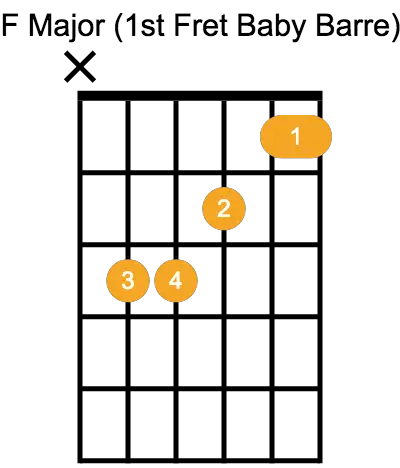
F Major – 1st Fret Barre
This is the F guitar chord that the majority of learners will spend weeks of their lives trying to master, get frustrated, and sometimes even give up! Don’t worry, everyone struggles to play barre chords at the beginning, it takes time to develop your finger dexterity and figure out the best technique.
The good news is that once you’ve learned this barre shape you can use it up and down the neck to play different major chords. It’s incredibly important that you stick it out and persevere with this chord shape because it’s used in thousands of your favorite pop, rock, and country songs.
When you take a look at the diagram below you’ll probably notice it’s almost identical to the “Baby Barre” that you’ve just played. All you need to do now is change the mini barre on the high E and B string into a full barre that covers the whole 1st fret!

Practice
Here are a few progressions that you can use to practice transitioning to and from an F major chord:
- C, F, and G
- C, Am, F, and G
- F, Gm, Dm, and C
Also, be sure to look at these songs because they use F major in the main chord progression:
- Eagle-Eyed Cherry – Save Tonight
- Adele – Rolling in the Deep
- Passenger – Let Her Go
- Coldplay – The Scientist
Intermediate
F Major – 8th Fret Barre
Continuing on from the barre chord theme we finished during the “Beginner” section; we have another common barre that is found throughout the guitar neck! You may also already be familiar with this shape if you’ve read our B Major article.
This variation of the F chord is a great alternative to the 1st fret barre because it offers a lovely high and full tone that combines well with other barre chords found around the 7th and 8th fret.
The fingering can be a little tricky if you’ve never played this shape of barre before because it requires your 2nd, 3rd, and 4th finger to squeeze together on 1 fret! Make sure you stick with practicing this chord because it’s going to be very useful when learning other intermediate level chord structures later.
Here’s the fingering for the chord:
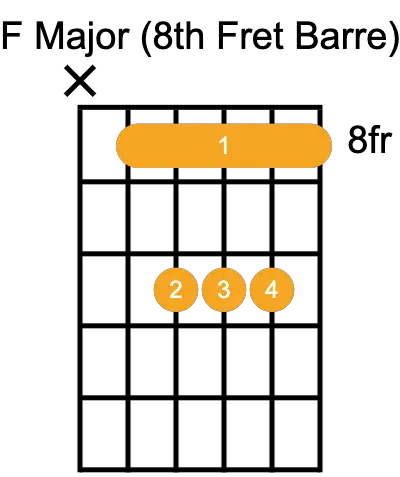
F Major – 8th Fret Triad
The 8th fret F chord triad isn’t a particularly difficult or complex chord to play; in fact, it’s basic finger positions make it ideal for beginners. However, this F shape is typically used by intermediate players because it combines well with other high-fret alternative chord shapes.
Because the chord is played on the high E, B, and G strings, it creates a clean sharp tone that cuts through low-mid sounds. This makes it an ideal chord choice for guitarists playing in a band.
Overall, the 8th fret triad is really easy to transition into and will make a great addition to your F major chord repertoire!
Have a look below to become familiar with the triad:
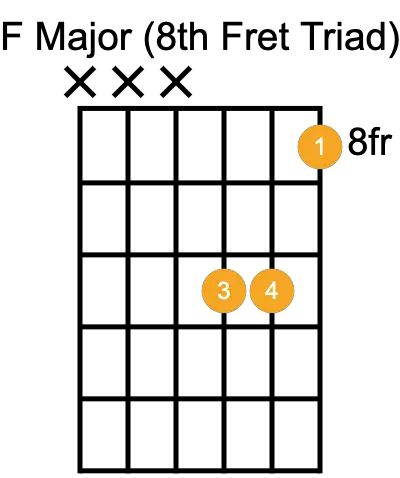
F Major – 5th Fret Complex Shape
As far as general F major guitar chords go, this fingering is amongst the most difficult to play and may take some time to perfect. The reason why it’s so difficult is that it awkwardly stretches along 4 frets while incorporating a mini barre.
As with anything in life that is challenging, persistence here is sure to pay huge dividends. Your finger dexterity and flexibility will increase (which allows you to play much more complex chord structures), and there’s also the fact that this F major shape just sounds beautiful!
The area in which you’ll need the most patience is with your little finger. You’ll need to build up its strength so that it can pin down the tough A string without causing any buzzing.
Be sure to spend a bit of time on this one:
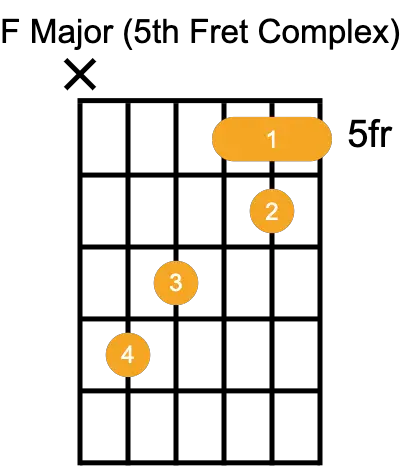
Advanced
F Major Pentatonic Guitar Scale (Solo)
So now that you’ve made it all the way through to the advanced section you should hopefully have all 6 of the F guitar chord shapes at your disposal! The next bit of info will have you shredding in the key of F major in no time (so that you can combine your chord and lead skills).
You may or may not have previously heard the term “pentatonic scale”, but it refers to a 5 note scale that can be alternatively used instead of the more traditional 7 note scales. The 5 notes that you’ll find in the F Major Pentatonic are as follows:
- F, G, A, C, and D
The great thing about mastering pentatonic scales is that they’re one of the easiest to play (and again to put it simply, they sound awesome)! Thousands of licks, riffs, and solos are based around the pentatonic scale so it’s a great place to start exploring the world of lead guitar!
Take a look at the image below and practice the different F major pentatonic scale positions that can be found throughout the fretboard.
Remember to use all your fingers (including your little finger!) when playing the scale, you’ll have a much more diverse and impressive playing style if you can comfortably use all your fingers to solo!
What’s next?
Congratulations! You’ve made it through all 3 sections and mastered the F guitar chord. If you want to continue developing your F major guitar skills, check out our How to Play F Major 7th Chords article (coming soon) to add a special touch to your playing style.
Feel like sharing? We would love to hear about your F major learning experience and how you use this new chord in your playing repertoire. Comment below with any questions, and we’ll be happy to help.


